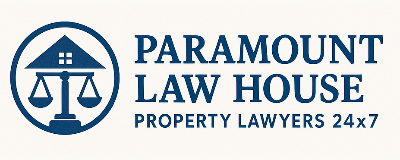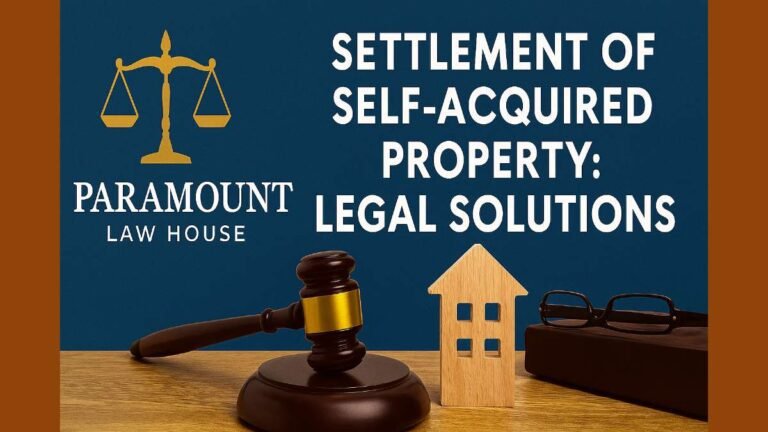Indian Easements: Legal Guidance for Property Owners
Indian Easements: Welcome, property owners. At Paramount Law House: Property Lawyers 24×7, we understand the complexities of property law. Today, we delve…
Indian Easements: Welcome, property owners. At Paramount Law House: Property Lawyers 24×7, we understand the complexities of property law. Today, we delve into the crucial concept of easements under Indian law. This knowledge is vital for protecting your property rights. Let’s explore this important legal aspect together.
Indian Easements: Legal Guidance for Property Owners: Paramount Law House
Understanding Easements
An easement is a right. It allows the owner of one piece of land to use another’s land for a specific purpose. This right does not transfer ownership. Instead, it grants a limited privilege. Think of it as a non-possessory interest in another’s property. For instance, your neighbor might have an easement to use your driveway to access their property. This right is legally binding. It affects both the land benefiting from the easement and the land burdened by it.
The land that benefits from the easement is called the “dominant heritage.” Conversely, the land that bears the burden is the “servient heritage.” This distinction is fundamental in easement law. It clarifies which property holds the right and which is subject to it.
Types of Easements under Indian Law
Indian law recognizes various types of easements. These are broadly categorized. One common type is an “appurtenant easement.” This type is attached to the dominant heritage. It runs with the land. Therefore, if the dominant heritage is sold, the easement right is also transferred to the new owner.
Another type is an “easement in gross.” This type is not connected to any dominant heritage. Instead, it belongs to a specific individual. For example, a utility company might have an easement in gross to run power lines across your property. This right is personal to the utility company. It does not necessarily transfer with the sale of your land.
Furthermore, easements can be classified based on how they are created. We will discuss these creation methods in detail later. Understanding these different types is crucial. It helps in identifying the nature and scope of an easement affecting your property.
Creation of Easements
Easements can arise in several ways under Indian law. One common method is by “express grant.” This occurs when the owner of the servient heritage explicitly grants the easement to the owner of the dominant heritage through a written document, such as a deed. This document should clearly define the nature, extent, and purpose of the easement. Registration of this document is often required to provide legal validity and public notice.
Another way easements are created is by “implied grant” or “implied reservation.” This happens when the circumstances surrounding a property transfer suggest that an easement was intended, even if not explicitly stated. For instance, if a landowner sells a landlocked portion of their property, an easement of necessity for access over the remaining land might be implied. Similarly, an implied reservation might arise when a seller retains a landlocked portion and needs access over the sold portion.
“Prescriptive easements” are created through long, continuous, and uninterrupted use of another’s land for a specific purpose for a period of twenty years. This use must be open, notorious, and without the permission of the landowner. The user must exercise the right as if it were an easement, and the landowner must be aware of it or have the means to be aware of it.
“Customary easements” arise from local customs or usages that have been followed for a long time. These rights are recognized due to their long-standing acceptance within a particular community.
Finally, easements can arise by “necessity.” As mentioned earlier, this occurs when a property is landlocked and has no other means of access. In such cases, the law implies an easement over the neighboring land to provide necessary access.
Rights and Liabilities of Dominant and Servient Owners
The existence of an easement creates specific rights and liabilities for both the dominant and servient owners. The dominant owner has the right to use the servient heritage to the extent necessary for the enjoyment of the easement. This right must be exercised reasonably and without causing unnecessary damage to the servient heritage.
Conversely, the servient owner retains the general rights of ownership over their land. However, they must not interfere with the dominant owner’s lawful exercise of the easement right. The servient owner cannot obstruct the easement or make it less convenient for the dominant owner.
Disputes often arise regarding the extent and manner of using an easement. It is crucial for both parties to understand their respective rights and obligations. Clear documentation and mutual understanding can help prevent such conflicts.
Transfer and Extinguishment of Easements
Generally, an appurtenant easement is transferred automatically with the dominant heritage. When the dominant property is sold, the new owner acquires the easement rights. An easement in gross, being personal, may or may not be transferable depending on the specific terms of its creation.
Easements can be extinguished in several ways. One way is by “release,” where the dominant owner explicitly gives up their right to the easement through a written and registered document.
Another way is by “merger,” which occurs when the ownership of the dominant and servient heritages becomes vested in the same person. In such a case, the easement ceases to exist as one cannot have an easement over their own land.
“Abandonment” can also extinguish an easement. This requires a clear intention by the dominant owner to relinquish the right, coupled with an overt act demonstrating this intention. Mere non-use of the easement does not necessarily constitute abandonment.
An easement can also be extinguished by “destruction of either heritage.” If either the dominant or the servient heritage is permanently destroyed, the easement may come to an end.
Finally, an easement can be extinguished by “non-enjoyment.” If a prescriptive easement is not enjoyed for a continuous period of twenty years, the right is extinguished.
Legal Remedies for Violation of Easement Rights
When easement rights are violated, the dominant owner has several legal remedies available. They can file a suit for “injunction” to restrain the servient owner from interfering with the easement. An injunction is a court order that prohibits a party from doing a specific act.
The dominant owner can also sue for “damages” to recover any losses suffered due to the violation of their easement rights. The amount of damages awarded will depend on the nature and extent of the loss caused.
In some cases, the dominant owner may also have the right to “abate” the obstruction themselves, provided they do so peacefully and without causing unnecessary damage. However, this is a self-help remedy and should be exercised cautiously.
It is always advisable to seek legal counsel promptly if your easement rights are being violated. Delay in taking action can sometimes weaken your legal position.
Importance of Legal Counsel
Navigating the complexities of easement law can be challenging. Therefore, seeking legal guidance from experienced property lawyers is highly recommended. At Paramount Law House: Property Lawyers 24×7, we provide comprehensive legal services related to easements.
Our team can assist you in understanding your existing easement rights and obligations. We can also help in the creation of new easements through express grants. Furthermore, we can advise you on matters related to implied and prescriptive easements.
In case of disputes or violations of easement rights, our experienced lawyers can represent you effectively in legal proceedings. We can help you seek appropriate remedies, such as injunctions and damages.
We also provide assistance in matters related to the transfer and extinguishment of easements. Our goal is to protect your property rights and ensure your peace of mind.
Frequently Asked Questions
An easement is a legal right. It allows a property owner to use another person’s land for a specific purpose. This right does not grant ownership. Instead, it provides a limited privilege over the other property. For example, it could be the right to use a shared driveway.
Easements can arise in several ways. Firstly, an “express grant” involves a written agreement. Secondly, an “implied grant” can occur based on circumstances. Thirdly, “prescriptive easements” are created through long, continuous use. Fourthly, “customary easements” arise from local traditions.
As the “servient owner,” you still own your property. However, you cannot interfere with the easement holder’s lawful use. You must allow them reasonable access. The “dominant owner” has the right to use the easement as intended. They must do so without causing unnecessary damage to your property.
Yes, an easement can be extinguished. This can happen through a “release” by the easement holder. “Merger” occurs if both properties come under the same ownership. “Abandonment” requires clear intent and action. “Destruction” of either property can also terminate it. Finally, “non-enjoyment” of a prescriptive easement for twenty years can extinguish it.
If an easement right is violated, legal remedies are available. You can seek an “injunction” from the court. This order would stop the interfering action. You can also sue for “damages” to cover any losses incurred. Consulting a property lawyer is crucial for navigating these legal processes effectively.
Conclusion: Protecting Your Property Rights
Easements are an integral part of property law in India. Understanding the different types of easements, their creation, and the rights and liabilities associated with them is crucial for every property owner. This knowledge empowers you to protect your property interests effectively.
At Paramount Law House: Property Lawyers 24×7, we are committed to providing you with expert legal guidance on all property-related matters, including easements. Our dedicated team is available round the clock to address your concerns and provide timely assistance. Remember, proactive legal counsel can save you from potential disputes and ensure the secure enjoyment of your property rights. Contact us today for comprehensive property law solutions.
Read More
- Industrial Land Law Experts: Ensure Compliance and Protection
- Injunction Order Assistance: Protect Your Property Rights
- Joint Ownership of Property: Legal Assistance Available
- Land Acquisition Services: Navigate Legal Procedures
- Land Development Joint Venture Agreements: Legal Guidance
- Department of Law & Justice, Government of India






